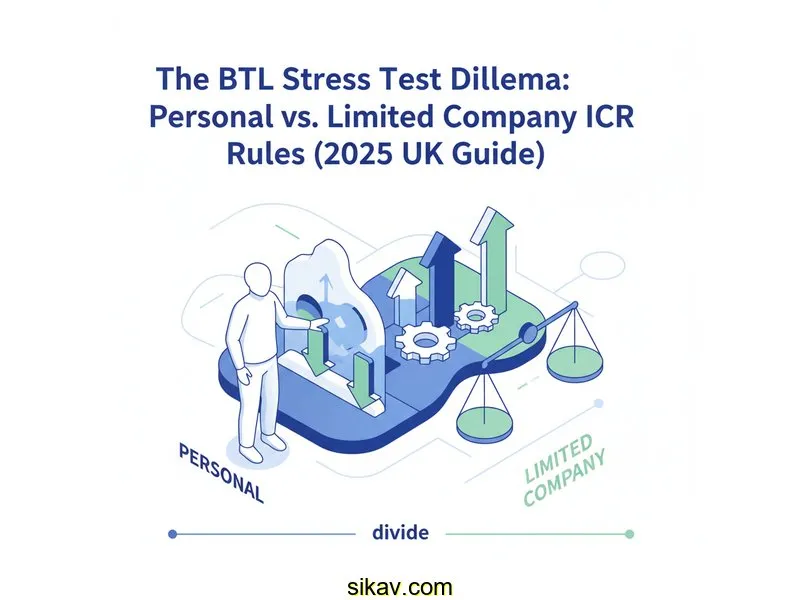
Picture this: You're a landlord in Birmingham looking to buy a new buy-to-let property. You find a property that generates £1,000 a month in rent. Your mortgage broker runs the numbers and tells you that, as a personal landlord, you can borrow a maximum of £150,000. Then, your friend, who owns a Limited Company (an SPV), looks at the *exact same property* and is told they can borrow £174,000. How is this possible?
If you've felt this confusion, you're not alone. Welcome to the complex, often-misunderstood world of buy-to-let (BTL) mortgage stress tests, specifically the Interest Coverage Ratio (ICR). Since the Prudential Regulation Authority (PRA) introduced stricter rules for personal landlords, the gap in affordability calculations between personal and corporate structures has become one of the most significant factors in modern property investment.
Getting this calculation wrong means wasting time on applications you can't win. But understanding it reveals the fundamental trade-off between the two main ways of investing in UK property. This isn't just a minor technicality; it's a core strategic decision.
Key Takeaways
- Core Rule 1: Stricter PRA stress test rules (e.g., 145% ICR) apply to personal BTL mortgages, but not to BTL mortgages held within a Limited Company (SPV).
- Core Rule 2: Lenders set their own 'in-house' stress test rules for Limited Companies, which are often (though not always) more lenient, such as a 125% ICR.
- Key Data Point: This difference is a major driver for incorporation. Over 340,000 BTL limited companies now exist in the UK, a number that grew by over 50,000 in 2023 alone (Hamptons, 2024).
- The Trade-Off: Limited Company mortgages may offer higher borrowing but typically come with higher interest rates and arrangement fees compared to personal BTL products.
- Disclaimer: This article provides informational guidance on mortgage affordability calculations as of November 2025. It is not financial or mortgage advice. Always consult a qualified, independent mortgage broker to analyze your specific circumstances.
What Is the BTL Stress Test (ICR)? An Analogy
Before we compare, let's establish what an Interest Coverage Ratio (ICR) stress test actually is. In short, it's a lender's way of ensuring you can still afford the mortgage payments even if interest rates rise significantly. They won't just check if the rent covers the mortgage at today's rate; they check if it covers the mortgage at a *higher*, hypothetical "stress rate."
Think of it like this: The ICR is a "financial speed limit" set by regulators and lenders.
- The rental income is your car's engine power.
- The mortgage payment is the load you're trying to pull.
- The stress test is the lender forcing you to prove you can pull that load up a steep hill (the 5.5%+ stress rate) *with a 45% margin of safety* (the 145% ICR).
The core confusion arises because there are two different sets of "speed limits" on the road: one for personal drivers (personal landlords) and one for professional haulage companies (Limited Company landlords).
Personal vs. Limited Company BTL Stress Test: The Key Differences
The rules diverge because of *who* sets them. The Prudential Regulation Authority (PRA), part of the Bank of England, introduced its tough affordability rules (SS13/16) in 2017 to cool the personal BTL market and ensure financial stability. Critically, these PRA rules do **not** apply to corporate lending.
This means lenders have to follow a strict minimum for personal BTLs, but they are free to set their own, more commercial "in-house" rules for Limited Companies. This has created a clear two-tier system.
Let's explore this head-to-head. The table below outlines the typical differences a landlord will face when applying for a BTL mortgage in 2025.
| Feature | Personal Buy-to-Let Mortgage | Limited Company (SPV) BTL Mortgage |
|---|---|---|
| Regulating Body | Prudential Regulation Authority (PRA) | Lender's 'In-House' Policy |
| Who do the rules apply to? | All personal BTL mortgage applications. | These mortgages are "non-PRA regulated," so lenders set their own commercial rules. |
| Typical ICR (Lower-Rate Taxpayer) | 125% | Often 125% (or set by lender) |
| Typical ICR (Higher-Rate Taxpayer) | 145% (or higher, e.g., 150%) | 125% (Lender may use a single rate for all SPV applicants) |
| Typical 'Stress Rate' Used | The *higher* of: 1) Product rate + 2%, 2) 5.5% (PRA floor), or 3) Lender's own floor. | The *higher* of: 1) Product rate + 2%, or 2) The lender's *own* floor (which might be 5.5% or lower). |
| Why the Difference? | The PRA rules (SS13/16) mandate this stricter test to protect individual borrowers and the wider financial system. | Lenders view SPV lending as a commercial proposition and are free to set rules they deem profitable and prudent. |
| The Practical Outcome | Lower maximum loan. The 145% hurdle requires much more rental income to support the same loan size. | Higher maximum loan. The 125% ICR is an easier hurdle to clear, allowing the same rent to support a larger loan. |
The Calculation in Practice: A 2025 Scenario
Let's revisit that £1,000-per-month rental property. This is where the maths becomes crystal clear. We will assume the lender's notional "stress rate" is 5.5% for both products, which is a common floor.
The annual rent is £1,000 x 12 = **£12,000**.
Scenario 1: Personal BTL (Higher-Rate Taxpayer)
The lender must use the PRA-mandated 145% ICR.
- ICR: 145%
- Stress Rate: 5.5%
- Calculation: The annual rent (£12,000) must cover 145% of the mortgage interest at 5.5%.
- Step 1 (Find required interest): £12,000 / 145% = £8,275. The rent must cover annual interest of £8,275.
- Step 2 (Find max loan): £8,275 / 5.5% = £150,454 (Maximum Loan)
Scenario 2: Limited Company (SPV) BTL
The lender is free from PRA rules and sets its own 'in-house' ICR, which is typically 125%.
- ICR: 125%
- Stress Rate: 5.5%
- Calculation: The annual rent (£12,000) must cover 125% of the mortgage interest at 5.5%.
- Step 1 (Find required interest): £12,000 / 125% = £9,600. The rent must cover annual interest of £9,600.
- Step 2 (Find max loan): £9,600 / 5.5% = £174,545 (Maximum Loan)
The result is stark. Simply by changing the borrowing structure, the same property with the same rent unlocks an additional **£24,000** in borrowing capacity. This is not a small difference; it's the entire deposit on another property.
Is It Always "Easier" to Pass in a Limited Company?
This is the critical question, and the answer is **no, not always.** While the ICR calculation is often more generous, it comes with significant trade-offs that must be factored in. This is why the "stress test dilemma" is such a key strategic choice for landlords.
The "easier" ICR calculation is often balanced by the lender with:
- Higher Interest Rates: Limited Company BTL mortgage products almost always have higher interest rates than their personal BTL counterparts. The "Big 6" high-street banks rarely lend to SPVs, so the market is dominated by specialist lenders who charge a premium.
- Higher Arrangement Fees: Fees for SPV mortgages are often a percentage of the loan (e.g., 2-3%) rather than a flat fee, making them much more expensive to set up.
- Extra Costs & Complexity: Running an SPV involves annual accountancy fees, Companies House filing, and potentially higher conveyancing costs, all of which eat into your profit.
This has driven the trend of incorporation. In fact, according to analysis of Companies House data, the number of active BTL limited companies in the UK has surged past 340,000 (Hamptons, 2024). This shift is not *just* for tax reasons (like offsetting all mortgage interest), but because the affordability test is a gateway. For many landlords, the SPV route is the only way to secure the loan amount they need to make a purchase viable.
Common Questions on BTL Stress Tests
Based on questions I've seen across landlord forums and r/UKPersonalFinance, here are the most common points of confusion.
1. Why is the ICR 145% for personal landlords but only 125% for a Limited Company?
This is the key distinction. The 145% (for higher-rate taxpayers) is a *regulatory minimum* set by the PRA for personal BTLs. The 125% is a *commercial decision* made by lenders for SPV lending, which is *outside* the PRA's scope. Lenders are simply free to set a lower bar for corporate entities, and they do so to compete for business.
2. Is the 5.5% 'stress rate' floor set by the PRA, and does it also apply to Limited Company mortgages?
The 5.5% minimum interest rate stress test is part of the PRA's 2017 guidance for *personal* BTL. Because SPV lending is not regulated by the PRA, lenders are not *required* to use 5.5%. However, in practice, most lenders use 5.5% or an even higher notional rate as their own 'in-house' floor for *both* personal and SPV lending as a matter of prudent risk management, especially in a high-inflation environment.
3. What about 5-year fixed rates? I heard the stress test is different.
This is true, and it's a crucial exception. The PRA rules allow lenders to use a more lenient stress test for *both* personal and SPV mortgages if the product is a 5-year (or longer) fixed rate. In this case, many lenders will calculate the ICR against the *actual product pay rate* (e.g., 4.99%) instead of the high 5.5%+ notional rate. This makes it much easier to pass the affordability test, which is why 5-year fixed products have become extremely popular with landlords.
Conclusion: Your Next Steps

Understanding the BTL stress test is no longer a "nice-to-have"—it's a fundamental part of investment planning in 2025. The key takeaway is that the affordability rules are not one-size-fits-all. The path you choose, personal or corporate, will have a direct and significant impact on the loan size you can achieve for any given property.
The "easier" 125% ICR for Limited Companies is a powerful tool for portfolio growth, but it must be weighed against the real-world costs of higher interest rates, larger fees, and administrative complexity. Conversely, the tougher 145% ICR for personal BTLs may limit your borrowing, but it's attached to products that are often cheaper and simpler. This guide provides the framework for that calculation, but for a decision this critical—one that involves tax, legal structures, and complex financing—always consult a qualified, independent mortgage broker who specializes in BTL finance.

